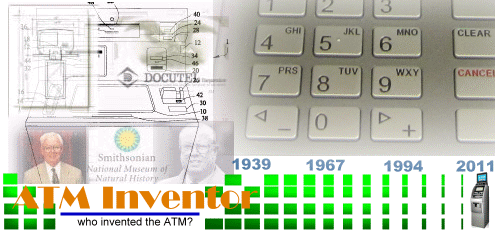Who invented the ATM? Part 3

The Jairus Larson Story:
By Anthony Miller as told from Jairus Larson
In 1973, the Director of Systems, and person in charge of ATM development at Diebold, was Larry Smiley. Larry was a former manager of mine at Univac (now Unisys) and was also familiar with the consulting company for which I was working at the time. Diebold had constructed a prototype, stand-alone ATM and had started the process of developing an on-line version. The prototype was functional but was deemed to be too rigid and non-maintainable to market and mass produce. Diebold had an impressive programming staff but it was very inexperienced. Larry obtained a budget and offered my company a contract for me to develop a machine that they could sell. (I remember the first budget/contract was $50K.)
Diebold provided me with all the resources that I required. They gave me a separate room at their research facility, copies of all existing programs, and access to, and cooperation of, a small group of people that were developing what would later become the Diebold standard online product – the TABS 600. I had access to the Product Manager and all other relevant personnel.
Initially, I analyzed the system flow and dissected each and every program. After that, I was able to determine what could be used, what should be discarded or replaced, what needed to be modified, and what new functions/programs would be required. During the construction phase, Diebold assigned two of their programmers to assist me. The product developed (TABS 500) was a stand-alone model. The first installed Diebold ATM was a drive-up model installed in Atlanta, GA.
The on-line ATM was not ready when the stand-alone ATM development
effort was complete. Larry was, of course, familiar with my communications
experience. I had previously developed three communications message
switches (Army, Navy and CDC/Litton Industries) plus a high speed
data communications system for NASA. He asked me if I could add communications
to the stand-alone version. The benefits would be:
1) A transition model for the existing banks.
2) At the time, ‘front-end’ systems for the banks did not
exist – an on-line/off-line version would enable the ATM to go
off-line when the bank communications was down. The ATM would always
be open.
3) Anything that I developed could probably be used by the existing
on-line development group. In that regard, I do not recall specifically,
but I am sure that I was also able to use parts of what had been developed
to-date by the existing on-line group. The resulting model that I
developed was called the Diebold TABS 550.
As far as I am aware, it was the very first online ATM. The first TABS 550’s were installed in Seattle and Spokane.
Some of the other principle people:
Roger Hellwinkle – a Diebold programmer that
assisted during the construction phase.
Don Chick – another Diebold programmer that
assisted during the construction phase. Actually, Don was the creator
of the screen presentation system that I believe gave Diebold a huge
advantage over the competition. It was the one part of the prototype
that I did not need to modify one bit.
Tim Stock, Sam Stewart, Bob Green – the team
that developed the online TABS 600.
Dick Clemmons – I am not completely sure about
his contribution but I know that he was involved with the off-line
prototype.
Copyright ©1998-2011
John D. White and James Goodfellow transcripts were written to ATMmachine.com.
A reference credit should be given to ATMmachine.com or a link back.
Want to link to this page? Who
invented the ATM? The Jairus Larson Story.
References
1. Research by ATMmachine.com
2. NMAH interview, 1995
3. John D. White
4. James Goodfellow, KCHS, I.Eng., FIIE